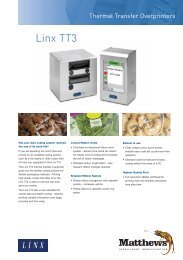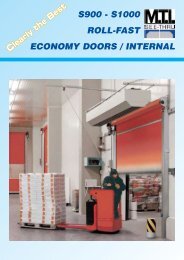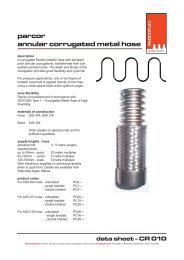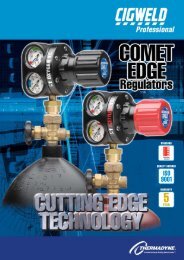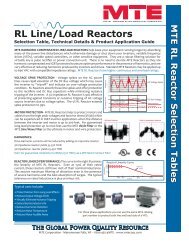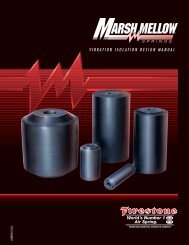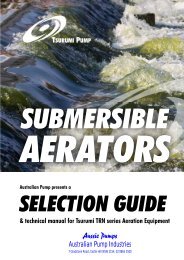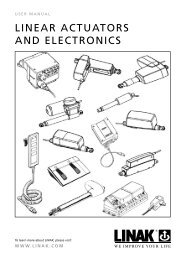Gas Monitors/Sensors - Ferret
Gas Monitors/Sensors - Ferret
Gas Monitors/Sensors - Ferret
You also want an ePaper? Increase the reach of your titles
YUMPU automatically turns print PDFs into web optimized ePapers that Google loves.
Permanent Instruments<br />
MSA offers a wide variety of permanent gas monitoring solutions to detect combustible gases,<br />
toxic gases, oxygen defi ciency/ enrichment. Our instruments refl ect the latest developments<br />
in sensor and instrumentation design, using electrochemical, catalytic bead, photoacoustic<br />
infrared (PIR) and both point and open path infrared sensing technologies, and offer wireless<br />
communication capabilities.<br />
We offer a wide range of systems to meet your facility’s monitoring needs: from a single sensor<br />
in a stand-alone application to a large-scale, completely computerized installation consisting<br />
of thousands of sensing points.<br />
MSA also designs custom systems that are tailored to fi t unique monitoring requirements.<br />
Contact your MSA representative for more information and ordering information.<br />
219 Customer Service: 1300 728 672 Website: www.msa.net.au New Zealand Customer Service 0800 441 335
<strong>Gas</strong> <strong>Monitors</strong>/<strong>Sensors</strong><br />
Ultima ® X Series <strong>Gas</strong> <strong>Monitors</strong> - State-of-the-art detection for any gas need<br />
Ultima ® X Series <strong>Gas</strong> <strong>Monitors</strong> feature the latest mechanical and electrical technologies<br />
to monitor against the threat of combustible and toxic gases and for oxygen defi ciency.<br />
Installation is simple and fl exible, and calibration is easy.<br />
Ultima ® X Series <strong>Gas</strong> <strong>Monitors</strong> feature the latest mechanical<br />
and electrical technologies to monitor against the threat<br />
of combustible and toxic gases and for oxygen defi ciency.<br />
Installation is simple and fl exible, and calibration is easy.<br />
Features<br />
Patented sensor disconnect under power allows for sensor<br />
change-out without declassifying a hazardous area.<br />
Interchangeable smart sensors can be replaced in the fi eld<br />
without the use of tools. The unit quickly recognizes the new<br />
sensor type and reconfi gures alarm and relay settings to<br />
optimize the new sensor.<br />
State-of-the-art liquid crystal display conveniently alternates<br />
between sensor reading and gas type and features scrolling<br />
messaging, indicating ongoing diagnostic checks such as<br />
sensor “end-of-life” condition.<br />
World-class design features a single-board design for<br />
ultimate reliability and serviceability. The multiple-entry<br />
mounting enclosure has been designed to be separate<br />
from the electronics and sensor, allowing for problem-free<br />
installation and servicing.<br />
Onboard optional “quick-check” LEDs and 4 relay outputs<br />
allow for increased indication of alarm and fault conditions.<br />
3 Models:<br />
Ultima ® XE Monitor: Explosion-proof stainless steel gas<br />
detector with display<br />
Ultima ® XA Monitor: Water-and corrosion-resistant,<br />
all-purpose, polycarbonate gas detector with display<br />
Ultima ® XIR Monitor: Explosion-proof stainless steel,<br />
infrared gas detector with display<br />
Ultima ® X3® Technology for the Ultima ® X Series<br />
<strong>Gas</strong> <strong>Monitors</strong> features:<br />
Multi-sensing<br />
System can handle 93 sensors<br />
(up to 31 monitors with up to 3 sensors per monitor)<br />
Customer Service: 1300 728 672 Website: www.msa.net.au New Zealand Customer Service 0800 441 335<br />
Permanent Instrument<br />
General Industry<br />
HVA<br />
Water & Wastewater<br />
Oil, <strong>Gas</strong> & Petrochemical<br />
Accepts any combination of electrochemical, catalytic and<br />
infrared sensors<br />
Scrolling display shows type and reading for all sensors<br />
Ultima ® X3 Monitor operates as a slave device on the network<br />
Signal boost<br />
Each sensor can be observed remotely up to 3,000 ft. from the monitor<br />
Universal 85-256VAC or 7-30VDC power supply available at<br />
remote condulet<br />
ModBUS RTU Output<br />
Industry-standard format<br />
Provides an RS-485 half-duplex communication interface<br />
Integration into PLC/DCS systems<br />
✔<br />
✔<br />
✔<br />
✔<br />
220
Permanent Instruments<br />
<strong>Gas</strong> <strong>Monitors</strong>/<strong>Sensors</strong><br />
Ultima ® XA Part Numbers<br />
Description Enhanced with Relays and Alarm Basic without Relays and Alarm Replacement <strong>Sensors</strong><br />
Ultima XA HCN 50PPM 765332 763127 765159<br />
Ultima XA H2S 100PPM 765284 765339 765227<br />
Ultima XA CO 500 PPM 763024 765338 765225<br />
Ultima XA NO 100PPM 765285 765341 765161<br />
Ultima XA NO2 10PPM 765331 765342 765160<br />
Ultima XA HCL 50PPM 765333 765343 765158<br />
Ultima XA CLO2 3PPM 765334 765344 765157<br />
Ultima XA PH3 2PPM 765335 765345 765162<br />
Ultima XA O2 25% 763023 765346 765228<br />
Ultima XA NH3 50PPM 765336 765347 765153<br />
Ultima XA LEL 100% LEL 765337 765381 765155<br />
Ultima XA H2 1000PPM 765407 765408 765380<br />
Ultima XA ASH3 2PPM 76409 765410 765378<br />
Ultima XA 10PPM 763752 765411 765379<br />
Ultima XA CL2 5PPM 765283 762918 765226<br />
Ultima XA SO2 25PPM 763025 765340 765229<br />
Ultima XA SO2 100PPM 765156<br />
221 Customer Service: 1300 728 672 Website: www.msa.net.au New Zealand Customer Service 0800 441 335
<strong>Gas</strong> <strong>Monitors</strong>/<strong>Sensors</strong><br />
<strong>Gas</strong> Detection System - TRIGARD Monitoring System for Chlorine and Sulfur Dioxide<br />
Application<br />
The MSA TRIGARD Monitoring System is designed for<br />
monitoring chlorine, sulfur dioxide and other toxic gases,<br />
as well as for oxygen defi ciency or enrichment. These new<br />
monitors were designed specifi cally for water and<br />
wastewater facilities which are typically large producers<br />
of these gases. The MSA TRIGARD Monitor offers an<br />
affordable monitoring solution for a variety of needs.<br />
Features<br />
Adjustable range<br />
Internal, pre-wired sensors in 25-, 50and<br />
100-foot lengths<br />
AC-powered<br />
On-board relays<br />
NEMA 4X design<br />
Highly visible LED indicators<br />
Piezo horn with horn silence button<br />
LCD display<br />
Long-life, MSA-designed sensors<br />
Simple push-button calibration<br />
Available as single-point or 3-point unit<br />
Advanced Features<br />
Sensor Disconnect Under Power: MSA’s patented feature<br />
allows for sensor change-out without declassifying a<br />
hazardous area.<br />
Interchangeable Smart <strong>Sensors</strong>: Pre-calibrated sensor<br />
modules are ready for installation out of the box. <strong>Sensors</strong> can<br />
be replaced in the fi eld without the use of tools.<br />
The unit quickly recognizes the new sensor type and<br />
reconfi gures alarm and relay settings to optimize the<br />
new sensor.<br />
State-of-the-Art Display: Liquid crystal display conveniently<br />
alternates between sensor reading and gas type and features<br />
scrolling messaging, indicating ongoing diagnostic checks<br />
such as sensor “end-of-life” condition.<br />
Specifi cations<br />
TRIGARD <strong>Gas</strong> Monitor showing single local<br />
sensor with two remote sensors attached.<br />
Factory-assembled remote<br />
sensors are available in<br />
25-, 50- and 100-foot lengths.<br />
<strong>Gas</strong> Type: Toxics & oxygen<br />
<strong>Gas</strong> Sampling: Diffusion<br />
Output Type: 4-20mA, 3-wire (non-loop power) - (single-point only) - ModBus RTU<br />
Sensor Location: Local or remote sensor (up to 100 ft.)<br />
Enclosure: General-purpose plastic enclosure<br />
Sensor Temperature Range: -25 to 40°C<br />
Accuracy: Repeatability +1% FS<br />
Sensor Life: 18 months to 2 years<br />
Relays: LEDs and relays<br />
Power Input: Internal 24VDC power supply<br />
Alarm Type: Peizo horn with horn silence button<br />
Battery Backup: Up to 24 hours<br />
Environmental Protection: Designed to meet NEMA 4X<br />
Customer Service: 1300 728 672 Website: www.msa.net.au New Zealand Customer Service 0800 441 335<br />
Permanent Instrument<br />
General Industry<br />
HVA<br />
Water & Wastewater<br />
Oil, <strong>Gas</strong> & Petrochemical<br />
✔<br />
✔<br />
✔<br />
✔<br />
World-Class Design: Engineering<br />
efforts feature a single-board design for<br />
ultimate reliability and serviceability.<br />
The mounting enclosure has been<br />
designed to be separate from the<br />
electronics and sensor, allowing for<br />
problem-free installation and servicing.<br />
Onboard LEDs and Relays: “Quickcheck”<br />
LEDs and four relay outputs<br />
allow for increased indication of alarm<br />
and fault conditions. “Quick-check”<br />
LEDs, viewable from up to 50 feet,<br />
indicate NORMAL (green) and<br />
ALERT (red) status conditions.<br />
Field-programmable alarm levels and<br />
normally energized/de-energized,<br />
normally opened/closed and latching/<br />
non-latching relay functions offer<br />
three levels of alarm and a fault.<br />
Options<br />
25-, 50- and 100-foot shielded cables<br />
on remote sensors<br />
Sulfur dioxide sensor option<br />
222
Permanent Instruments<br />
<strong>Gas</strong> <strong>Monitors</strong>/<strong>Sensors</strong><br />
Ultima ® XIR <strong>Gas</strong> <strong>Monitors</strong><br />
Infrared technology with display for combustible gas detection<br />
The Ultima ® XIR <strong>Gas</strong> Monitor is a microprocessor-based, infrared point gas detector for continuous monitoring of combustible<br />
gases and vapors. Designed around a rugged, 316 stainless steel enclosure, the monitor operates with dual-wavelength,<br />
heated-optics technology, providing defi nitive compensation for temperature, humidity and aging effects. The IR technology<br />
offers excellent long-term stability, eliminates the need for frequent calibrations and reduces the overall cost of ownership.<br />
Reliability<br />
Extremely fast speed of response<br />
Designed without a sintered disk for optimum performance in<br />
the harsh, offshore environment<br />
Operates over extended temperature ranges<br />
Immune to poisoning<br />
Operates in high-gas and low-oxygen environments<br />
“Fail to safety” operation<br />
Ease of Use<br />
LCD display with scrolling messaging<br />
Single-board design for ultimate reliability and easy,<br />
no-tool servicing<br />
Part No. Description<br />
766617 ULTIMA ® XIR PROPANE 2.1% with RELAYS IEC<br />
763675 ULTIMA ® XIR PROPANE 2.1% with RELAYS and WARNING LED<br />
766831 ULTIMA ® XIR PROPANE 1.7% with RELAYS IEC<br />
766618 ULTIMA ® XIR CH 5% with RELAYS IEC<br />
4<br />
766540 ULTIMA ® XIR CO 2% with RELAYS and WARNING LED<br />
2<br />
Ultima ® XI Series <strong>Gas</strong> Monitor - Infrared technology for combustible gas detection<br />
General Industry<br />
HVA<br />
Water & Wastewater<br />
Oil, <strong>Gas</strong> & Petrochemical<br />
Optional “quick-check” LEDs for increased product visibility<br />
No-gas calibration. A zero adjustment is all that is required<br />
for full calibration<br />
The Ultima ® XI <strong>Gas</strong> Monitor is a digital signal processor-based, infrared point gas detector for continuous monitoring<br />
of combustible gases and vapors. Designed around a rugged 316 stainless steel enclosure, the ULTIMA ® XI Monitor is a<br />
completely self-contained, explosion-proof unit that is dependable in harsh environments. Dual wavelength-heated optics<br />
technology, provides defi nitive compensation for temperature, humidity and aging effects. The IR technology offers<br />
excellent long-term stability, eliminates the need for frequent calibrations and reduces overall cost of ownership.<br />
Reliability<br />
Extremely fast speed of response<br />
Operates over extended temperature ranges<br />
Immune to poisoning<br />
Operates in high-gas and low-oxygen environments<br />
“Fail to safety” operation<br />
Part No. Description<br />
766823<br />
Ultima ® XI IEC Methane 100% LEL (4.4% CH ) 4<br />
766824 Ultima ® XI IEC Propane 100% LEL (1.7% C H ) 3 8<br />
223 Customer Service: 1300 728 672 Website: www.msa.net.au New Zealand Customer Service 0800 441 335<br />
✔<br />
✔<br />
✔
<strong>Gas</strong> <strong>Monitors</strong>/<strong>Sensors</strong><br />
Toxgard ® II <strong>Gas</strong> Monitor<br />
- Versatile monitor for combustible gas, toxic gas or oxygen defi ciency detection<br />
Simplicity/Ease of Use<br />
Large, four-digit LED display<br />
Large LED alarm indicators<br />
Internal relay contacts for FAULT, CAUTION, WARNING<br />
and ALARM<br />
Failsafe fault relay output<br />
Diagnostics that appear on the display<br />
Audible alarm<br />
4 to 20 mA output<br />
Automatic calibration<br />
“Replace Sensor” indication when sensor nears<br />
its end-of-life<br />
Real-time clock for time and date stamping of events<br />
Logging of minimum, maximum and average gas<br />
concentrations over predetermined time intervals<br />
Selectable lock-out of output signals during calibration to<br />
inhibit alarms and control actions<br />
Digital, multi-drop communication<br />
Customer Service: 1300 728 672 Website: www.msa.net.au New Zealand Customer Service 0800 441 335<br />
General Industry<br />
HVA<br />
Water & Wastewater<br />
Oil, <strong>Gas</strong> & Petrochemical<br />
Externally-mounted plug-in sensor is easily replaced<br />
Remote sensor enables sensors and transmitters to be<br />
separated for installations where access to the sensor<br />
may be diffi cult<br />
Some UL Class I, Div 2 approvals apply<br />
Flexibility<br />
Can be used as a transportable<br />
gas monitor with its optional<br />
internal battery<br />
Three levels of alarm<br />
Optional integral pump for sample<br />
draw systems<br />
Durability<br />
Housed in a rugged, metal NEMA 4X enclosure,<br />
or standard steel version<br />
Sensorgard protects sensor from dirt and water and acts<br />
as a baffl e in windy environments<br />
Part No. Description<br />
223370 Toxgard ® II CO 100PPM Banshee Wailer Strobe Battery Backup Diffusion<br />
223371 Taxgard ® II CO 500PPM Banshee Wailer Strobe Battery Backup Diffusion<br />
223372 Toxgard ® II O 25% Banshee Wailer Strobe Battery Backup Diffusion<br />
2<br />
223373 Toxgard ® II H S 50PPM Banshee Wailer Strobe Battery Backup Diffusion<br />
2<br />
223374 Toxgard ® II NO 10PPM Banshee Wailer Strobe Battery Backup Diffusion<br />
2<br />
223375 Toxgard ® II CL 5PPM Banshee Wailer Strobe Battery Backup Diffusion<br />
2<br />
223376 Toxgard ® II HCN 50PPM Banshee Wailer Strobe Battery Backup Diffusion<br />
223377 Toxgard ® II SO 25PPM Banshee Wailer Strobe Battery Backup Diffusion<br />
2<br />
766645 Toxgard ® II HCL 100PPM Banshee Wailer Strobe Battery Backup Diffusion<br />
766646 Toxgard ® II CLO 3PPM Banshee Wailer Strobe Battery Backup Diffusion<br />
2<br />
766647 Toxgard ® II NO 100PPM Banshee Wailer Strobe Battery Backup Diffusion<br />
223378GS Toxgard ® II LEL REM SOLVENTS Banshee Wailer Strobe Battery Backup<br />
223378NG Toxgard ® II LEL CH4 REM Banshee Wailer Strobe Battery Backup<br />
223378PV Toxgard ® II LEL PETR REM Banshee Wailer Strobe Battery Backup<br />
223380 Toxgard ® II CO 100PPM Banshee Wailer Strobe Battery Backup Pump<br />
223381 Toxgard ® II CO 500PPM Banshee Wailer Strobe Battery Backup Pump<br />
223382 Toxgard ® II O 25% Banshee Wailer Strobe Battery Backup Pump<br />
2<br />
223383 Toxgard ® II H S 50PPM Banshee Wailer Strobe Battery Backup Pump<br />
2<br />
766648 Toxgard ® II NO 10PPM Banshee Wailer Strobe Battery Backup Pump<br />
2<br />
223385 Toxgard ® II CL2 5PPM Banshee Wailer Strobe Battery Backup Pump<br />
223386 Toxgard ® II HCN 50PPM Banshee Wailer Strobe Battery Backup Pump<br />
223387 Toxgard ® II SO 25PPM Banshee Wailer Strobe Battery Backup Pump<br />
2<br />
766649 Toxgard ® II HCL 100PPM Banshee Wailer Strobe Battery Backup Pump<br />
766650 Toxgard ® II CLO 3PPM Banshee Wailer Strobe Battery Backup Pump<br />
2<br />
766651 Toxgard ® II NO 100PPM Banshee Wailer Strobe Battery Backup Pump<br />
Permanent Instrument<br />
✔<br />
✔<br />
✔<br />
224
Permanent Instruments<br />
<strong>Gas</strong> <strong>Monitors</strong>/<strong>Sensors</strong><br />
Chemgard ® Series Infrared <strong>Gas</strong> <strong>Monitors</strong><br />
- Precise photoacoustic IR monitoring of a variety of industrial gases such as hydrocarbons,<br />
solvents, alcohols, alkanes and toxics<br />
General Industry<br />
225 Customer Service: 1300 728 672 Website: www.msa.net.au New Zealand Customer Service 0800 441 335<br />
HVA<br />
Water & Wastewater<br />
Oil, <strong>Gas</strong> & Petrochemical<br />
The Chemgard ® Series of <strong>Gas</strong> <strong>Monitors</strong> provide low-cost, high-performance monitoring that is extremely stable and highly<br />
selective to the gas of interest. Detectability is as low as 0.01 ppm for certain applications, and the unit can operate for months<br />
with virtually no zero drift.<br />
Simplicity/Ease of Use<br />
Direct-reading display shows actual gas value, alarms and<br />
diagnostic messages<br />
Data logging provides access to date-stamped information on key<br />
events including gas readings, alarms and fault conditions. Data is<br />
accessible through the front panel display or the RS-232 port.<br />
Easy to install, operate and maintain<br />
Easy-to-read display showing gas concentration(s) and alarms<br />
Three alarm levels with relay output<br />
All user functions confi gurable through front panel<br />
Three system alarm levels with relays<br />
Normally energized trouble and alarm relays for failsafe operation<br />
Flexibility<br />
Variety of output ranges<br />
3 enclosure styles: explosion-proof, NEMA 4, or rack-mounted<br />
Can be expanded to monitor up to 8 locations simply by adding the<br />
multipoint sequencer option<br />
Chemgard Application Table<br />
Operates over a wide temperature range<br />
Can be installed in numerous environments and confi gurations<br />
Monitor one, four or eight sampling points per instrument<br />
Discreet relays expandable up to 3 per sample line (separate enclosure)<br />
COMPOUND 10 PPM 100 PPM 1000 PPM 1% 10% 100% 100% LEL Current Min. Detection (PPM) TLV (PPM)<br />
Acetaldehyde Y 4 25<br />
Acetic Acid Y* 1 10<br />
Acetone Y Y Y 3 500<br />
Acetonitrile<br />
Acetylene***<br />
Y 40 40<br />
Acrylonitrile Y* Y Y(0-20%) 3 2<br />
Ammonia Y 4 25<br />
Benzene Y* Y 10 0.5<br />
Butane Y Y Y 3 800<br />
1,3 Butadiene Y 3 2<br />
1-Butyl Acetate Y 4 150<br />
Carbon Dioxide*** Y* Y Y Y Y Y 0.04 5000<br />
Carbon Monoxide Y Y Y Y 4 25<br />
Carbon Tetrachloride Y 3 5<br />
Chloroform Y* Y 1 10<br />
Cyclopentane Y 3 600<br />
1,2 Dichloroethane Y 4 10<br />
Diethyl Ether Y Y 3 400<br />
Difl uoromethane Y 3<br />
Dimethylacetamide Y* 2 10<br />
Dimethylamine Y 4 5<br />
✔<br />
✔<br />
✔
<strong>Gas</strong> <strong>Monitors</strong>/<strong>Sensors</strong><br />
Chemgard ® Application Table cont.<br />
COMPOUND 10 PPM 100 PPM 1000 PPM 1% 10% 100% 100% LEL Current Min. Detection (PPM) TLV (PPM)<br />
Dimethyl Ether Y 4<br />
Dimethyl Ethyl Amine Y 4<br />
Dowtherm J Y* 5 10<br />
Ethane Y Y 3<br />
Ethanol Y Y 3 1000<br />
Ethanolamine Y 20 3<br />
Ethyl Acetate Y Y 3 400<br />
Ethyl Benzene Y* 5 100<br />
Ethylene Y* Y 2<br />
Ethylene Oxide Y Y Y 4 1<br />
Formic Acid Y* 1 5<br />
Halon 1211 Y 3<br />
Halon 1301 Y 3<br />
Heptane Y* Y Y Y 1 400<br />
Hexafl uoropropylene Y 4<br />
Hexafl uoro 1,3, Butadiene Y* Y 0.4<br />
Hexane Y* Y Y Y Y 1 50<br />
Hexene Y 50 30<br />
HFC 245fa Y 3<br />
HFE 347E Y 3<br />
HFE 7100 Y 3 600<br />
Isceon 89 Y 3<br />
Isobutane Y Y Y 3<br />
Isohexane Y 4 500<br />
Isopar G Y 3<br />
Isopentane Y Y Y 4 600<br />
Isopropanol Y Y Y 4 400<br />
Methanol Y 4 200<br />
Mek Y* Y Y 1 200<br />
Methyl Chloride Y Y 20 50<br />
Methyl Formate Y 4 100<br />
Methane Y* Y Y Y Y 5<br />
Methyl Fluoride Y* Y 3<br />
Methyl Iodide Y 4 2<br />
MIBK Y 4 50<br />
Methyl Methacrylate Y 3 100<br />
Methyl Morpholine Y* 1<br />
Methylene Chloride Y 3 50<br />
Methylene Fluoride Y 4<br />
Methyl N-Propyl Ketone Y 4 200<br />
Monomethylamine Y 4 5<br />
Customer Service: 1300 728 672 Website: www.msa.net.au New Zealand Customer Service 0800 441 335<br />
Permanent Instrument<br />
226
Permanent Instruments<br />
<strong>Gas</strong> <strong>Monitors</strong>/<strong>Sensors</strong><br />
Chemgard ® Application Table cont.<br />
COMPOUND 10 PPM 100 PPM 1000 PPM 1% 10% 100% 100% LEL Current Min. Detection (PPM) TLV (PPM)<br />
Nitrogen Trifl uoride Y* Y 0.4 10<br />
Nitrous Oxide Y* Y 1 50<br />
Octafl urobutane Y 3<br />
Octafl uoropropene Y* Y 0.4<br />
Pentane Y Y Y 3 600<br />
Perchloroethylene Y* Y 1 25<br />
Perfl uorohexane Y 1<br />
PF 5050 Y 3<br />
Phosgene Y* Y* 0.5 0.1<br />
PMVE Y 3<br />
Propanal Y 4<br />
2-Propanol Y Y Y Y 4 400<br />
N-Propanol Y 3 200<br />
Propane Y Y Y 3 2500<br />
Prop. Glyc. Dimeth. Acetate Y 4<br />
Propylene Oxide Y 4 20<br />
Solkane 365/227 Y Y 3<br />
Styrene Y* 5 20<br />
Sulfur Hexafl uoride Y* Y Y 0.05 1000<br />
Tetrahydrofuran Y 3 200<br />
Tetrafl uoroethylene Y 4<br />
Toluene Y Y 5 50<br />
1,1,1 Trichloroethane Y 4 350<br />
1,1,2 Trichloroethane Y 4 10<br />
Trichloroethylene Y* Y 0.4 50<br />
Triethylamine Y 4 1<br />
Vinyl Acetate Y 4 10<br />
Vinyl Chloride Y* Y 1 1<br />
Vinyl Fluoride Y Y Y 3 1<br />
0-Xylene Y 4 100<br />
M-Xylene Y 4 100<br />
P-Xylene Y 4 100<br />
Xylenes Y 3 100<br />
Y = Acceptable Application<br />
* NOT CE APPROVED APPLICATION<br />
** Other applications and ranges are possible<br />
*** Carbon Dioxide: 20-50% Range Available<br />
**** Acetylene: 0-20% Range Available<br />
Hydrocarbon vapors from complex mixtures such as <strong>Gas</strong>oline, Diesel, Jet Fuels and Kerosene have been detected by calibrating<br />
for a simulant gas such as Propane or Pentane.<br />
227 Customer Service: 1300 728 672 Website: www.msa.net.au New Zealand Customer Service 0800 441 335
<strong>Gas</strong> <strong>Monitors</strong>/<strong>Sensors</strong><br />
SafEye Open Path Detection System<br />
- Long-range detection of combustible gases<br />
Customer Service: 1300 728 672 Website: www.msa.net.au New Zealand Customer Service 0800 441 335<br />
General Industry<br />
HVA<br />
Water & Wastewater<br />
Oil, <strong>Gas</strong> & Petrochemical<br />
MSA’s SafEye Open Path <strong>Gas</strong> Detection System is a self-contained optical gas detection system. Using breakthrough technology,<br />
the SafEye Detector can detect combustible gases below the lower explosion limit (LEL) range over an open path up to 450 feet<br />
long. Open Path gas monitoring is cost-effective, providing complete gas detection of an open area along a line of sight. Standard<br />
point-type gas monitors provide coverage at the location of the sensor only while Open-Path provides complete linear coverage<br />
across an open area. Advan-tages include lower installation and maintenance costs, as one SafEye <strong>Gas</strong> Detection can<br />
replace ten or more point-type detectors.<br />
Simplicity/Ease of Use<br />
Available in various confi gurations, for both short-path and<br />
long distance applications<br />
Multiple outputs for easy fi eld installation<br />
No oxygen required for proper operation<br />
Built-in temperature sensor enables automatic temperature<br />
change compensation<br />
Easily installed without special tools or equipment<br />
Front-facing LEDs provide all the necessary information for<br />
alignment, zeroing and normal operation<br />
Factory-calibrated to typical hydrocarbons that may<br />
leak in a location<br />
Patented fl ash source allows detector to synchronize with<br />
the source IR energy, preventing false alarms from sunlight,<br />
welding, etc.<br />
Chillgard ® RT Photoacoustic Infrared Refrigerant Monitor<br />
- The industry stadard for refrigerant leak detection monitors<br />
The Chillgard ® RT Photoacoustic Infrared Refrigerant Monitor provides economical, low-level monitoring of refrigerant gases used<br />
in most refrigeration systems or chillers. By detecting leaks early enough to prevent a major loss of refrigerant gas, the monitor<br />
reduces operating costs. Chillgard ® RT <strong>Monitors</strong> meet the requirements of ANSI/ASHRAE 15-2004.<br />
Sensor Technology<br />
The Chillgard ® RT Monitor utilizes very stable and highly<br />
selective photoacoustic infrared (IR) technology to sense<br />
refrigerant gases at levels as low as 1 part-per million.<br />
Can operate for months with virtually no zero drift<br />
Inherent stability eliminates the need for auto-zeroing<br />
techniques that take the monitor “off-line” at regular<br />
intervals, leaving the area unprotected<br />
“Fresh air” sampling line or “on-line” scrubber is<br />
not required<br />
High immunity to interferents such as cleaning<br />
agents and solvents<br />
Unaffected by changes in humidity<br />
Operates over a wide temperature range<br />
Detects single or multiple refrigerants<br />
Permanent Instrument<br />
Expandability<br />
Simply by adding the<br />
Multipoint Sequencer, the<br />
Chillgard ® RT Refrigerant<br />
Monitor can be expanded to<br />
monitor up to 8 locations.<br />
Part No. Description<br />
764971<br />
Chillgard ® RT cw Strobe, 4 sample point R123, R22,<br />
R134a, R404a, R407c, R410a<br />
765861<br />
Chillgard ® RT cw Strobe, 8 sample point R123, R22,<br />
R134a, R404a, R407c, R410a<br />
228371 Chillgard ® RT cw Strobe, 4 sample point Ammonia<br />
227796 Chillgard ® RT cw Strobe, 8 sample point Ammonia<br />
✔<br />
✔<br />
✔<br />
228
Permanent Instruments - Environment<br />
<strong>Gas</strong> <strong>Monitors</strong>/<strong>Sensors</strong><br />
Chillgard ® LE Refrigerant Monitor<br />
- Refrigerant sensor and control module in one enclosure<br />
The Chillgard ® LE Photoacoustic Infrared Refrigerant Monitor<br />
provides fast, reliable and economical low-level monitoring of<br />
refrigerant gases used in most refrigerant systems or chillers,<br />
including R123, R 134A, R 11, R12 and R22. The full scale<br />
range of the unit is 0-1,000 ppm with the capability of measuring<br />
a refrigerant leak as low as 20 ppm, well below the established<br />
threshold limit values.<br />
Single point diffusion or 4- point pumped models<br />
Complies with ANSI/ASHRAE 15-2001<br />
Part No. Description<br />
765280 Chillgard ® LE 240V 4PT R11<br />
765281 Chillgard ® LE 240V 4PT R12<br />
765282 Chillgard ® LE 240V 4PT R22<br />
763209 Chillgard ® LE 4Pt R134a Pump, Strobe<br />
Chillgard ® LS Refrigerant Monitor - Flexible, reliable gas monitor<br />
Available in either single-point diffusion (no pump needed)<br />
or 4-point pumped version for remote sampling<br />
Works as either a stand-alone unit or in conjunction with<br />
the Chillgard ® LC Control Module<br />
Full scale range of 0-1,000 ppm with the capability of<br />
measuring as low as 20 ppm<br />
Fast reliable detection for low level leaks prevents a major<br />
loss of costly refrigerant gas<br />
Integral status LEDs and optional strobe provide visual<br />
indication of refrigerant level<br />
Chillgard ® LC Control Module - Microprocessor-based controller<br />
General Industry<br />
229 Customer Service: 1300 728 672 Website: www.msa.net.au New Zealand Customer Service 0800 441 335<br />
HVA<br />
Water & Wastewater<br />
Oil, <strong>Gas</strong> & Petrochemical<br />
The Chillgard ® LS Refrigerant Monitor detects the fi ve most commonly used refrigerant gases (R-11, R-12, R-22, R-123 and R-134a).<br />
Standard features include fi ve LED’s to indicate power, alarm and fault conditions, 4-20 mA output and communication to the<br />
Chillgard ® LC Control Module. The Chillgard ® LS Refrigerant Monitor sensor module meets the requirements of ASHRAE 15 for<br />
detection below the TLV for refrigerant gases.<br />
The MSA Chillgard ® LC Control Module can communicate with up to eight<br />
sample points from Chillgard ® LS Refrigerant <strong>Monitors</strong>. The Chillgard ® LC<br />
Module remotely displays gas concentration, alarm status, calibration<br />
and fault diagnostics for the LS <strong>Monitors</strong>.<br />
Expandable: Confi gurable with up to 8 LS sensor module<br />
points of detection<br />
Easy to use: 20-position LCD display with 4-button keypad<br />
3 LEDs-POWER, FAULT and ALARM-give a quick visual<br />
indication of monitor status<br />
✔<br />
✔
<strong>Gas</strong> <strong>Monitors</strong>/<strong>Sensors</strong><br />
Chillgard ® M-100 Photoacoustic Infrared Refi gerant Monitor<br />
- Refrigerant sensor and control module in one enclosure<br />
MSA’s CHILLGARD ® M-100 Refrigerant sensor is designed to detect<br />
the presence of the most common halogenated refrigerants in<br />
cold storage facilities, mechanical equipment rooms and other<br />
refrigerant applications. This compact sensor can be mounted<br />
almost anywhere to detect potential leaks of halogenated<br />
refrigerants. Easy installation ensures fast and practical integration<br />
into existing automated systems.<br />
Low-level detection – down to as low as 20 ppm<br />
Versatility – capable of operating within a wide temperature<br />
and humidity range<br />
Low maintenance – no moving parts<br />
Easy installation – simply secure back plate to wall<br />
Proven photoacoustic infrared refrigerant sensor<br />
Applications<br />
Cold-storage facilities<br />
Meat-packing plants<br />
Mechanical equipment rooms<br />
Solvent-cleaning stations<br />
Other specialist applications<br />
Ordering Information<br />
CHILLGARD ® M-100 is available with a number of options including:<br />
Refrigerant gas detected<br />
Temperature & Relative Humidity sensors<br />
Current or voltage analogue output or RS-458 ModBUS digital output<br />
De-icer option operates at temperatures down to –30 °C<br />
CHILLGARD ® M-100 can be confi gured for individual requirements.<br />
Please contact your MSA representative for ordering details.<br />
Part No. Description<br />
766678 Chillgard ® M-100 R134a, 407a, 407c, 427c cw RH/T & de-icer<br />
766679 Chillgard ® M-100 R123 cw RH/T & de-icer<br />
766680 Chillgard ® M-100 R404a, 422a, 422d, 507c cw RH/T & de-icer<br />
766681 Chillgard ® M-100 R22 cw RH/T & de-icer<br />
Customer Service: 1300 728 672 Website: www.msa.net.au New Zealand Customer Service 0800 441 335<br />
Permanent Instrument<br />
230
Permanent Instruments<br />
<strong>Gas</strong> <strong>Monitors</strong>/<strong>Sensors</strong><br />
Chillgard ® NH3 <strong>Gas</strong> Monitor - In Freezer Ammonia Detection<br />
Provides fast, reliable detection of low-level ammonia leaks<br />
Simplicity/Ease of Use<br />
Single-board design for ultimate reliability and serviceability<br />
Interchangeable Smart <strong>Sensors</strong> - pre-calibrated sensor modules are<br />
ready for installation out of the box. <strong>Sensors</strong> can be replaced in the<br />
fi eld without the use of tools<br />
Integral display and status LEDs provide visual indication of the<br />
ammonia level in an area<br />
State-of-the-art display – liquid crystal display (LCD) conveniently<br />
alternates between sensor reading and gas type and features<br />
scrolling messaging, indicating ongoing diagnostic checks such as<br />
sensor “end-of-life” condition<br />
Onboard LEDs and relays - optional “quick-check” LEDs and four<br />
relay outputs allow for increased indication of alarm and fault<br />
conditions. Quickcheck LEDs, viewable from afar, indicate NORMAL<br />
(green) and ALERT (red) status conditions<br />
Simple and fl exible installation and operation<br />
Easy-to-follow calibration instructions displayed on monitor<br />
No need to open the enclosure during set-up and calibration when<br />
using accessory calibrator or controller<br />
Part No. Description<br />
10064883 0-1000 ppm NH3, with heater<br />
10064884 0-1000 ppm NH3, with heater, relays and LED’s<br />
General Industry<br />
HVA<br />
Water & Wastewater<br />
Oil, <strong>Gas</strong> & Petrochemical<br />
231 Customer Service: 1300 728 672 Website: www.msa.net.au New Zealand Customer Service 0800 441 335<br />
✔<br />
✔
<strong>Gas</strong> <strong>Monitors</strong>/<strong>Sensors</strong><br />
<strong>Gas</strong>gard ® Family of Products<br />
- Versatile, compact, cost-effective gas monitors<br />
The MSA <strong>Gas</strong>gard ® family of products includes the <strong>Gas</strong>gard ® 1 and <strong>Gas</strong>gard ® 8 <strong>Monitors</strong>. Designed to work with any 2- or 3-wire<br />
4-20 mA input signal, these monitors offer expanded features and options, selectable through user-friendly software.<br />
Each monitor uses micro-processor-based technology and provides effective and reliable monitoring of toxic and<br />
combustible gases as well as for oxygen defi ciency. Each monitor’s measuring range includes<br />
PPM, % LEL and % Volume.<br />
Features<br />
Each channel has:<br />
- 4 levels of alarm with LED indicator and failsafe relay output for<br />
each alarm level<br />
- Fault alarm with LED indicator and failsafe relay output<br />
- Individual digital LED display and electronics<br />
- 4-20 mA output signal<br />
- Selectable measuring range<br />
- Audible alarm<br />
- Easy-to-program alarm levels<br />
- User-selectable relay contact positions<br />
- Confi gurable external reset switch or fl ow failure fault status<br />
Additional Features for the <strong>Gas</strong>gard ® 8 Monitor<br />
Field-expandable and programmable<br />
Common Alarm and Fault LED indicators and relay outputs<br />
1 to 8 channels<br />
FlameGard ® Series of Flame Detectors<br />
Fast, reliable optical fl ame detection for hydrocarbon-based fi res<br />
3 Versions:<br />
FlameGard ® UV Flame Detector: monitors UV radiation<br />
FlameGard ® UV/IR Flame Detector:<br />
dual-optical sensing monitors UV and IR radiation<br />
FlameGard ® IR3 Flame Detector:<br />
patented triple-IR technique monitors IR radiation with<br />
enhanced immunity to false alarms<br />
Uses a patented triple-infrared (IR) detection technique that<br />
offers two to three times the detection distance (up to 200 ft)<br />
of conventional IR or UV/IR detectors.<br />
Simplicity/ Ease of Use<br />
Easy to operate and maintain<br />
Easily mounted via a simple bracket or the optional<br />
Swivel Mount Kit<br />
Customer Service: 1300 728 672 Website: www.msa.net.au New Zealand Customer Service 0800 441 335<br />
Permanent Instrument<br />
<strong>Gas</strong>gard 1<br />
Alarm time delay for each channel<br />
RS-232 and RS-485 output<br />
General Industry<br />
HVA<br />
Water & Wastewater<br />
Oil, <strong>Gas</strong> & Petrochemical<br />
<strong>Gas</strong>gard 8<br />
MSA FlameGard ® Flame Detectors provide constant monitoring for fi re or fl ame by detecting the characteristic ultraviolet (UV)<br />
and/or infrared (IR) radiation from a hydrogen or hydrocarbon-fueled fi re.<br />
They operate as a stand alone unit without a control panel, or can be connected to a fi re or security panel via an internal<br />
alarm or accessory relay. FlameGard ® Detectors reduce the possibility of false alarms because the units must receive the proper<br />
wavelength, duration and intensity of the fi re’s radiation before an alarm is activated.<br />
Durability<br />
Enclosed in heavy-duty, copper-free, explosion-proof<br />
aluminum or stainless steel housings<br />
✔<br />
✔<br />
✔<br />
✔<br />
232
Calibration and Sensor Placement<br />
Instrument Calibration<br />
Whether an instrument warns and/ or<br />
alarms at the proper time depends on<br />
its ability to translate the quantity of<br />
gas it detects into an accurate reading.<br />
“Calibration” refers to an instrument’s<br />
measurement accuracy relative to a<br />
known concentration of gas.<br />
<strong>Gas</strong> detectors perform relative<br />
measurements: rather than independently<br />
assessing the quantity of gas present,<br />
they measure the concentration of the<br />
air sample and then compare it to the<br />
known concentration of the gas that the<br />
instrument is confi gured to sample.<br />
This “known concentration” serves<br />
as the instrument’s measurement scale,<br />
or reference point.<br />
If the instrument’s reference point has<br />
moved, then its reading will also move.<br />
This is called “calibration drift” and it<br />
happens to most instruments over time.<br />
(Common causes of calibration drift<br />
include the normal degradation of<br />
sensors, exposure of the sensor to<br />
poisons, and harsh operating conditions.)<br />
When an instrument experiences<br />
calibration drift it can still measure the<br />
quantity of gas present, but it cannot<br />
convert it into an accurate numerical<br />
reading. Regular calibration with a<br />
certifi ed standard gas concentration<br />
updates the instrument’s reference<br />
point, re-enabling it to produce<br />
accurate readings.<br />
There are two methods of verifying<br />
instrument calibration: through a<br />
functional or “bump” test (or span check)<br />
or by performing a full calibration. Each is<br />
appropriate under certain conditions<br />
Calibration Kits<br />
- For calibrating instruments and sensors<br />
MSA calibration kits, when used with the appropriate<br />
calibration gas, offer a quick, convenient, and economical<br />
method of checking the response of MSA gas sensors and<br />
gas detection instrumentation.<br />
Calibration kits contain all the components necessary to<br />
calibrate your MSA equipment.<br />
They are housed in a lightweight carrying case for easy<br />
transportation to the job site or sensor location. MSA also has a<br />
wide assortment of calibration gases available.<br />
Bump (or Span) Check<br />
A bump check is a means of verifying<br />
calibration by exposing the instrument<br />
to a known concentration of test gas.<br />
The instrument reading is then compared<br />
to the actual quantity of gas present (as<br />
indicated on the cylinder). If the instrument’s<br />
response is within an acceptable range<br />
of the actual concentration then its<br />
calibration is verifi ed. When performing<br />
a bump test, the test gas concentration<br />
should be high enough to trigger the<br />
instrument alarm. If the bump test results<br />
are not within the acceptable range,<br />
then a full calibration must be performed.<br />
Full Calibration<br />
A full calibration is the adjustment of<br />
the instrument’s reading to coincide<br />
with known concentrations (generally a<br />
certifi ed standard) of zero and span<br />
gases, to compensate for calibration drift.<br />
In most cases, a full calibration is only<br />
necessary when an instrument does<br />
not pass the bump test (or after it has<br />
been serviced).<br />
Zero Check<br />
A zero check is performed to verify<br />
that the instrument reads true zero<br />
(also referred to as the “baseline”)<br />
in an environment in which no amount<br />
of target gas is present. Common<br />
situations in which a zero check is<br />
performed include:<br />
after exposure of the sensor to a sensor<br />
contaminant<br />
after the sensor has been exposed to a<br />
very high concentration of the target gas<br />
General Industry<br />
233 Customer Service: 1300 728 672 Website: www.msa.net.au New Zealand Customer Service 0800 441 335<br />
HVA<br />
Water & Wastewater<br />
Oil, <strong>Gas</strong> & Petrochemical<br />
✔<br />
✔<br />
✔<br />
✔<br />
as the sensor ages, since it may<br />
gradually drift<br />
after the unit has operated in<br />
varying background conditions<br />
(e.g. humidity levels)<br />
after exposure to extreme conditions<br />
(e.g. high temperature or humidity)<br />
If the instrument fails the zero check,<br />
then a zero adjustment - which sets<br />
the instrument to true zero - should<br />
be performed.<br />
Frequency of Calibration<br />
The frequency of calibration depends on<br />
the sensor’s operating time, conditions<br />
of use (including chemical exposure)<br />
and user experience with the instrument.<br />
New sensors should be calibrated more<br />
often until the calibration records prove<br />
sensor stability.<br />
The calibration frequency can then<br />
be reduced to the schedule set by<br />
the safety offi cer or plant manager.<br />
Before calibrating the sensors, it is good<br />
practice to apply power to the unit to<br />
allow the sensor to adapt to the new<br />
environment.<br />
<strong>Sensors</strong> should be powered at least<br />
one full hour before any calibration<br />
attempt is made.
MSA Guide to <strong>Gas</strong> Sensor Selection and Placement<br />
STEP 1: To determine where to place<br />
sensors, perform an analysis of the<br />
potential gas hazards in your facility.<br />
STEP 2: Create drawings indicating<br />
all potential leak sites, as well as<br />
the severity of each site’s hazard<br />
potential.<br />
There are two main categories of<br />
hazardous locations:<br />
A. Potential gas discharge<br />
points. These are places<br />
where hazardous gases may be<br />
released, such as valve stem<br />
seals, gaskets, compression<br />
fi ttings and expansion joints.<br />
B. Potential contact areas.<br />
These are places where<br />
hazardous gases may endanger<br />
workers, or damage equipment<br />
or property. Examples include<br />
populated areas, confi ned<br />
spaces, pits, stairwells, crawl<br />
spaces, shelters, and residential,<br />
business and industrial environments<br />
located nearby.<br />
STEP 3: Since gases do not always<br />
behave in the same way, take air<br />
fl ow conditions, as well as potential<br />
gas pockets, into consideration<br />
before placing sensors. MSA smoke<br />
tubes (P/N 458481) can be useful in<br />
measuring the direction and rate of<br />
air fl ow to determine areas where<br />
gases may accumulate.<br />
Calibration and Sensor Placement<br />
In general, when placing sensors<br />
the following principles should be<br />
considered:<br />
Place sensors in areas where the<br />
air currents are likely to produce the<br />
highest gas concentration, including<br />
areas where gas buildup is likely,<br />
such as corners or stopping points<br />
of moving devices that release gas.<br />
If you are attempting to take a<br />
representative room sample, do not<br />
place sensors near entrances or<br />
fresh air vents (because the sample<br />
concentration will be diluted by<br />
incoming air) unless there is a need to<br />
sample that specifi c area of the room.<br />
Place sensors close to the possible<br />
gas/leak source.<br />
Place combustible gas sensors<br />
between the potential leak and the<br />
ignition source.<br />
Place toxic gas and oxygen sensors<br />
between the potential leak and the<br />
populated area, and in the workers’<br />
breathing zone.<br />
Consider ease of access to the sensor<br />
for maintenance requirements, such as<br />
periodic calibration. Use a remote sensor<br />
for high or inaccessible locations.<br />
<strong>Gas</strong> Density and Sensor Placement<br />
Note: This is for informational purposes only and is intended for use as a general guide to important considerations in sensor placement.<br />
It is not intended to serve as an exhaustive review of all considerations. Due to the large number of variables present, each site<br />
should be considered individually by a trained professional. The services of an Industrial Hygienist (CIH) or Safety Professional (CSP)<br />
should be considered if an onsite survey is required.<br />
Customer Service: 1300 728 672 Website: www.msa.net.au New Zealand Customer Service 0800 441 335<br />
Avoid mounting sensors near radio<br />
transmitters or other RFI-producing<br />
sources (e.g., welding activity and<br />
induction heaters), to reduce possible<br />
RF interference.<br />
Avoid locations where airborne<br />
particles may coat or contaminate<br />
the sensor, such as paint booths.<br />
Install sensors in a position that<br />
prevents water or dust accumulation<br />
on the sensor head (which may impede<br />
the diffusion of gas into the sensor).<br />
The preferred position is facing<br />
downward, but horizontal placement<br />
is also acceptable.<br />
Facility air intakes are generally good<br />
locations for sensors.<br />
Ensure that the entire area in<br />
question is suffi ciently monitored,<br />
including little-used areas such as<br />
closets, warehouses and other<br />
storage areas.<br />
Factor in the vapor density of the<br />
monitored gases when compared<br />
to air.<br />
<strong>Gas</strong>es <strong>Gas</strong> Density Sensor Placement<br />
carbon dioxide,<br />
heavy hydrocarbons<br />
greater than air closer to the ground<br />
hydrogen, methane less than air near the ceiling<br />
General Industry<br />
carbon monoxie, nitrogen similar to air according to air current path,<br />
at or near breathing level<br />
(usually 4 to 6 ft. from fl oor)<br />
HVA<br />
Water & Wastewater<br />
Oil, <strong>Gas</strong> & Petrochemical<br />
✔<br />
✔<br />
✔<br />
✔<br />
234




